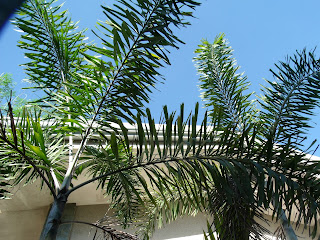Summer is official in the Philippines. Weather in Pangasinan has a prevailing temperature of 34 degrees but it feels like 36 degrees Centigrade making it a dry season. Where the scorching heat is too harsh for the plants, finding ways and means to beat the heat are the main concerns to sustain the plants’ needs. Frequent watering will help the plants in a way, but the dry air will cause the leaves to lose the water they’ve absorbed at a faster rate.
Some plants love broken shades. So grateful I have these palm trees even for a small garden that I have, they add a tropical look.
 |
| Foxtail Palm, Wodyetia Bifurcata |
 |
| Hyophorbe Laginicaulis, Champagne Tree |
 |
| Verichia Merillii, Manila Palm Tree |
 |
| Majesty Palm |
Others fronds burn easily that a patio umbrella is needed for a filtered sunlight effect. Ferns are sensitive to bright light and they may find it too intense for them. Now I know where I should put these ferns...(sigh)
 |
| Staghorn fern |
 |
| Asplenium Nidus |
 |
| Patio Umbrella |
To sustain the requirement of constant humidity, I surround the containers with moist pebbles.
 |
| Pebbles help in increasing the humidity as the water evaporates. |
Or I simply put the pebbles here...
 |
| I opted for white pebbles. |
Daily misting is a sure way to give the plants exact amount of humidity. I would not want to oversupply them with water as the soil may turn soggy. When the humidity is low, I mist the plants several times a day especially during daylight hours.
At any rate, I do keep plants in close group, rather than scattered about to help ease their need for humidity.
I am linking this post to Carolyn at
thisgrandmothersgarden as I join her in her Walk in the Garden Challenge for this month.